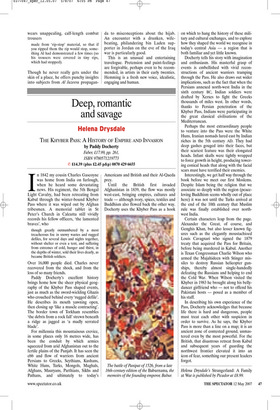Brushes with strangers
Justin Marozzi
MISADVENTURE IN THE MIDDLE EAST: TRAVELS AS TRAMP, ARTIST AND SPY by Henry Hemming Nicholas Brealey, £10.99, pp. 298, ISBN 9781857883954 ✆ £8.79 (plus £2.45 p&p) 0870 429 6655 There are probably better ways to welcome tourists to your country than with the words, ‘Go home England. Bastards.’ To their credit, Henry Hemming and his travelling companion Al, both suspected by the Slovak border guards of being Islamic extremists and denied entry, do not go home. With a retaliatory cry of, ‘Go home Slovakia. Bastards,’ they drive away in their beloved truck Yasmine and the journey continues.
And it is quite a journey. Fresh from university, the two fledgling artists travel through Turkey, Iran, Oman, Jordan, Saudi Arabia, Syria, Lebanon, Egypt, Israel and Iraq. Their mission: ‘an artistic expedition to the heart of the Islamic world in order to alter Western stereotypes of the region.’ Like many such lofty ambitions, the objective soon succumbs to reality along the way and the journey becomes instead a more introspective story of self-discovery.
Penniless, as all young artists should be, the pair must put on exhibitions wherever they can. In Tehran, where they are told theirs is only the third foreign exhibition in Iran since the 1979 revolution, they don’t sell as many pictures as they would like, which is also just as it should be. Some Spectator readers may wince a little at the terminology the artists use. For instance, they only ever seem to ‘make art’, rather than paint. Al spends a good deal of time immersed in what he calls his ‘paint-feelings’. These are later superseded by ‘nature-cultures’.
One mean-spirited reviewer of this book dismissed what she called its dubious ‘studenty solipsism’. A more generous verdict would call it youthful exuberance, smile indulgently at some of the more pretentious observations and admire Hemming’s chutzpah. The pair get into more than their fair share of scrapes, in part because of the author’s unkempt appearance and slightly foreign features. The eccentric looking Yasmine, complete with mashallah (God has willed it) stencilled onto her side, stuffed with multiple editions of the Koran and other Islamic literature, does little to lower their profile at border crossings, either. In Turkey, they are briefly detained as suspected spies. In Isfahan, it is not long before other art students brand them ‘foreign schemers’.
Hemming is determined at all costs to avoid the Orientalist tag. He is not seeking to explore historical connections which he says is ‘too easy’, something Robert Byron or William Dalrymple would do. Given the panorama of his travels, you can understand why he shrinks from history, but a traveller without a sense of it is, in a sense, without a compass. It is easy to lose your bearings if you don’t know where you or the people you are among have come from.
What Hemming offers instead is a refreshing innocence and openness, a voracious appetite for experience and encounter that make him an honest and empathetic writer. He is funny with it. In Jeddah, he sends up the pathetic male lechery which even the all-over covering of the woman’s abaya cannot prevent. The sartorially challenged Al wears unappealing, calf-length combat trousers
made from ‘rip-stop’ material, so that if you ripped them the rip would stop, something Al had demonstrated a few times (so his trousers were covered in tiny rips, which had stopped).
Though he never really gets under the skin of a place, he offers punchy insights into subjects from Al Jazeera propagan da to misconceptions about the hijab. An encounter with a drunken, wifebeating, philandering bin Laden supporter in Jordan on the eve of the Iraq war is particularly good.
This is an unusual and entertaining travelogue. Pretension and paint-feelings are forgivable, perhaps even to be recommended, in artists in their early twenties. Hemming is a fresh new voice, idealistic, engaging and human.











































































 Previous page
Previous page